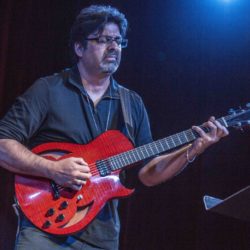
Rez Abbasi’s Street-Smart Jazz
For Manhattan-based jazz guitarist and composer Rez Abbasi, much of his output, starting with his first release as a bandleader in 1993, lives at the intersection of Indian classical music and post-bop (a synthesis of bebop, modal jazz, free jazz, and fusion). And while that eclectic mix of sound naturally lends itself to a transcendence of genre, Abbasi has remained connected to the various musical traditions he’s explored over the years. But his having that connection doesn’t necessarily mean he has “respect” for tradition. “Not ‘respect,’” he says. “I don’t like that word. The connotations of that are religious, in a way. You have to have a sincere love and understanding for the music, but you can get someone who has a ‘respect’ for it who can’t play anything.“Yet, anybody I work with comes from the tradition that they’ve established themselves in,” he continues. “Whether it’s jazz, Indian classical music, Brazilian samba, it doesn’t matter. I just want some authenticity in the music before we start venturing off, because that’s where I come from. It makes for a strong art form when you’re trying different things.”In collaboration with sitarist Josh Feinberg and under the moniker Naya Baaz, Abbasi actualizes that symbiosis of creative adventure and a loyalty to one’s roots while taking an Indian-classical-influenced, hybrid approach to jazz on his 16th album, Charm. The album, however, is a lot bigger than just a mashup of those two genres.There’s the track, “Bekhayal (Without a Thought),” which burns with a repetitive, Discipline-era King Crimson intensity, and “Bhairavi,” which feels more open-ended and spacey. The title track is built around a recurring, descending line, and sounds downright bluesy. The album features some lush acoustic guitar, too, although Abbasi primarily plays electric, and sometimes even adds a little hair, like on the otherwise Pat Metheny-esque “Reaching.” Given the project’s nature, sitar drones ring throughout, although they sound surprisingly organic and never gimmicky, and provide a wonderful juxtaposition to Abbasi’s generally darker tone and lightning-quick leads. “The only reason I did it, quite honestly, is that sitarist Josh Feinberg—he’s obviously an American—actually knows a lot about jazz,” Abbasi shares. “He’s studied with Dave Holland, Paul Bley, and some really incredible jazz stalwarts, and knowing that, I thought, ‘Okay, here’s an opportunity that hasn’t been tackled in music history. It’s not going to be a band that has five Indian classical musicians and one jazz artist; it’s going to be both of us, who can sort of tangle with both sides of the spectrum.’ Josh is more on the Indian classical side and I am more on the jazz side, which is a bit of the irony of this whole project. I knew it could be a really interesting project. He understands chromaticism and harmonic modulation, which are some of the key points of jazz. You don’t really have jazz unless you have harmony. Because of that, I knew something could happen.”It doesn’t hurt that Abbasi also has impeccable chops to add to that synthesis of their respective educations. Abbasi, who emigrated with his family to the U.S. from Pakistan at the age of 4, has been honing his technique since at least the 1980s, when he was a student at the University of Southern California (USC) and studied under the tutelage of masters like Paul LaRose, Peter Sprague, and Joe Diorio. After USC, he moved to New York City and finished up his degree at the Manhattan School of Music. “Joe Diorio said to me, ‘Rez, you should move to New York City. You have the New York sound,’” he laughs. “Whatever that was, at 20 years old. I don’t know, but I took it as a compliment.”In New York, he studied with guitarists like Rodney Jones and Jack Wilkins, although he describes his lessons as more of a “study/hang situation.” His teachers turned him on to the music and history of jazz, giving him records to listen to, and having him transcribe chords from orchestral arrangements. That somewhat informal vibe continued when he traveled to India after graduation and met up with some of the masters there. “Ustad Alla Rakha is one of the preeminent tabla players in the world,” he says. “It was a loose hang with him, too. I don’t know if I’d call it studying, but it was an adventure to be in his classroom several times. That, along with listening to music all over the place, and buying—it was cassette tapes back then—and immersing myself in that music, and the culture, too—that was the lesson itself.”“Whether it’s jazz, Indian-classical music, Brazilian samba, it doesn’t matter. I just want some authenticity in the music before we start venturing off, because that’s where I come from.”Those years of immersion and woodshedding are obvious in his voice as an improviser, although Abbasi says that being in that role can be limiting, too. “If I wasn’t improvising, I could probably pull off everything a lot more effortlessly,” he says. “But I am in the heat of the moment. I am playing with the drummer a lot and we’re exchanging ideas—and I don’t know what’s going to come up.”In a sense, not knowing what’s going to come up—being in an almost constant state of experimentation and discovery—is indicative of Abbasi’s overall approach as well, especially as that relates to incorporating Indian-classical concepts into a jazz context. “I wrote a book for Hal Leonard, New Dimensions in Jazz Guitar: Expand Your Improvisatory Consciousness, and I am continually working on the stuff that I wrote because I didn’t master it,” he says. “These are concepts that contain a larger picture of music that takes a lot of evolution to get through. That book talks specifically, among other things, about how Indian music has influenced me on a street level. I didn’t study Indian music, but I’ve heard it so much—I’ve played with so many musicians—that I am allowing my intuition to speak through that.”Rez Abbasi and Josh Feinberg lead a Naya Baaz performance, including Jennifer Vincent on cello and drummer Ernie Adams, showcasing their unique blend of the unmistakably Indian-classical voice of Feinberg’s sitar, and Abbasi’s distinctive jazz tones.Despite his in-depth osmosis of Indian music, Abbasi faced some challenges with working with Feinberg on Charm, due to some of the sitar’s constraints when brought into a Western context. “You only play on one or two strings, and the leaps that we do as 6-string guitar players are very different,” Abbasi says about the sitar. “You can play all the notes on there, but there are some limitations to doing that. There are specific keys that you are working with, and everything for Josh is in D, which is weird. For this project, I tuned the lowest string on my guitar to D [drop D] and I kept the rest in standard. I had more of a bass-heavy thing going on with this band, and the texture with the cellist was at times very thick and beautiful.”Charm, like so much of Abbasi’s catalog, includes a “street level” approach to music in general. As he tells it, jazz was not a conservatory music; its development was more informal, with musicians exchanging ideas and working them out on their own. That, in a sense, is also how he accesses Indian music. He’s studied and knows what he’s doing, although in essence, he’s primarily relying on intuition.“If I hear music—any music in fact—I let it filter through my body and hopefully, intuitively, something will come out because I love it so much,” he says. “But it’s not fully that either, because I have looked into it specifically. There are specific things you have to learn. A raga is a raga; it’s not a scale. There’s a reason it’s a raga and not a scale. I know those things, but to actually play a raga in concert, no, I can’t do that.”Rez Abbasi’s GearGuitarsSadowsky semi-hollowHomer T Guitar Co. T-styleYamaha APX-5A acoustic/electricGuild SongbirdMichael Kelly Guitars acousticWashburn Custom Shop steel-string acoustic, modded to be fretlessAmpsHeadstrong Lil’ King-S comboTech 21 Trademark 60EffectsStrymon CloudburstEventide H9 MAXEmpress SuperdelayEmpress ParaEq MKII DeluxeSource Audio Nemesis DelayLandgraff Dynamic OverdriveRoland EV-5 Expression PedalJ. Rockett Audio Designs Blue Note OverdriveElectro-Harmonix Superego PlusDunlop DVP4 Volume (X) MiniStrings & PicksD’Addario custom set (.013–.050)Dunlop Jazztone 208 2 mm picksDunlop Primetone on acousticIt also means that while he’s blending Indian ideas into jazz, he’s still playing jazz—specifically, jazz guitar. “I won’t be imitating a sitar player—I won’t be studying sitar for that matter, either—because I don’t want my guitar playing to sound like I am imitating that,” he says. “It is really important to allow my intuition to take what I’ve heard and come up with the goods.”When it comes to the delivery of those goods, Abbasi isn’t using an arsenal of expensive, boutique gear. He’s got a handful of workhorses, including two modestly priced acoustics and one semi-hollow electric from Roger Sadowsky, which has replaced the D’Angelico he used for years. But “a guitar is only a tool,” he says. “It just has to hum.”And when the instrument is humming, it allows the musician to reach for something transcendent, which for Abbasi, at this mature stage in his career, is where the true freedom lies. “The filter I’m working with now is how not to impose my conditioning and thinking onto the music, but to let the music serve me,” he says. “Before I used to think that I had to serve the music, and that I was going to bring my personality into the music. Now it’s reversed and it’s become less controlling, and through that comes freedom.”
Read more »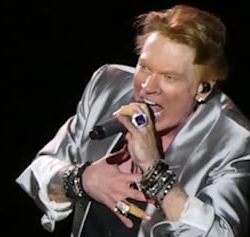
Watch GUNS N’ ROSES Perform In Hershey During Summer/Fall 2023 North American Tour
The markit aneight YouTube channel has uploaded video of GUNS N’ ROSES’ August 11 performance at the Hersheypark Stadium in Hershey, Pennsylvania. Check out the clips below.
The band’s setlist was as follows, according to Setlist.fm:
01. It’s So Easy
02. Bad Obsession
03. Chinese Democracy
04….
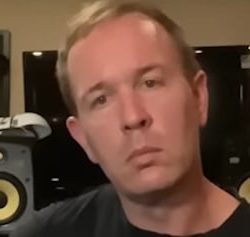
BRENDON SMALL Says METALLICA’s ‘Some Kind Of Monster’ Was ‘An Important Part Of The Genesis’ Of ‘Metalocalypse’
During an appearance on the latest episode of “Nu Pod”, the Knotfest podcast hosted by Joshua Toomey and Ro Kohli, Brendon Small, co-creator of “Metalocalypse”, the hit animated series on Adult Swim featuring the fictitious metal band DETHKLOK, spoke about how he drew inspiration from METALLICA’s 20…
Read more »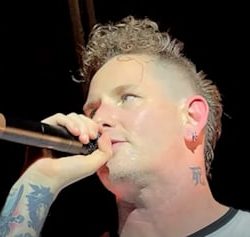
COREY TAYLOR Blasts Conspiracy Theorists: ‘Belief Is Not A Fact’
In a new interview with NME, SLIPKNOT frontman Corey Taylor spoke about the dangerous rise of conspiracy theorists in America and other parts of the world, with an increasing number of people believing in theories that go against rational thoughts, scientific facts and recorded truth. He said (as tr…
Read more »
Best impulse responses 2023: the secret sauce of great recorded guitar tone
Take your recordings to another level with these high-quality cab IRs from York Audio, GGD, Ownhammer, ML Soundlabs, and more
Read more »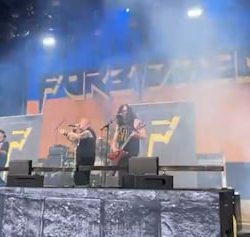
Watch: New FORBIDDEN Lineup Performs At Belgium’s ALCATRAZ Festival
Resurrected San Francisco Bay Area thrash metal veterans FORBIDDEN played their first European show last night (Friday, August 11) at the Alcatraz festival in Kortrijk, Belgium. Video and photos of the band’s performance can be found below.
The new FORBIDDEN lineup — consisting of Craig Locicero (gu…
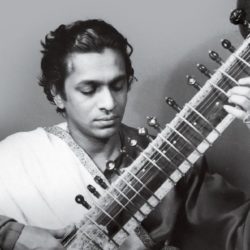
Raga Rock
In the mid-1960s legions of rock guitarists, having spent years studying the American blues tradition, suddenly found themselves looking for new musical inspiration. Unexpectedly, numerous American and British musicians turned their attention to India as a source for new melodic possibilities. There are several theories for why this is (and who was first), but most likely it is because of three overlapping events.In early 1965, while the Beatles were filming their second movie, Help!, George Harrison became fascinated by the sitar during a scene in which the Fab Four go to an Indian restaurant. Later, during the summer of that year, David Crosby (then of the Byrds) gave Harrison a Ravi Shankar album, thereby solidifying Harrison’s interest in Indian music, and providing us the English/American connection. Finally, in the fall of 1965, Harrison would record himself playing sitar on “Norwegian Wood,” more or less initiating the raga rock style. Coincidently, also in the summer of 1965, the Yardbirds recorded “Heart Full of Soul,” which originally had a sitar player booked for the session. According to Jeff Beck, as he demonstrated the song’s hook for the sitarist, Beck himself realized that he could play the part better–exaggerating the vibrato and bends to mimic the sitar. More on that later.One last detail before we proceed: One of the clichés of raga rock is to simply add traditional Indian instruments to a recording–sitar, tabla, tamboura, etc. You’ll hear this in countless songs recorded between 1965 and 1969. This lesson will have none of that. Instead, the examples here take Indian musical techniques and approaches and apply them to the guitar (and to a lesser degree the accompaniment). In my opinion, this is the best of raga rock–stylistic influence, not artless impersonation. There is also a certain naiveté in the finest of this music: While George Harrison went on to study Indian music seriously with Ravi Shankar, others were interested in creating a general atmosphere that could be gleaned from listening and experimentation. Most of the examples demonstrated here highlight those attributes. A Raga Rock TimelineOne of the best places to start with Raga Rock is the relatively simple D major scale exercise found in Ex. 1, which comes directly from a video of George Harrison demonstrating the basics of sitar techniques, while Ravi Shankar watches.What makes this example Indian-influenced is the fact that the scale is played entirely on one string, moving up and down the fingerboard (as opposed to over or across) and it keeps pedaling back to the open D string. The vibrato is also exaggerated throughout. It’s worth pointing out that Harrison clearly fumbles at the beginning of the exercise–even Beatles slip up!Ex. 2 takes this scale-on-one-string idea one step further (as several of this lesson’s specimens will) by mixing modes while droning the D string throughout. Inspired by Paul McCartney’s solo on “Taxman”, this phrase uses both the major 7 (C#) and the b7 (C natural) in measure two, while emphasizing the b3 (F natural) in measure three and, conversely, the major 3 (F#) in measure four. This modal mixture is a hallmark of raga rock.As mentioned in the introduction, another early example of Indian-influenced guitar phrasing is Jeff Beck’s playing on the Yardbird’s “Heart Full of Soul”. Thus, Ex. 3 imitates Beck imitating the sitar, with exaggerated bends and vibrato. Once again over a D drone, this time implying a D Mixolydian sound. Note: In order to keep the drone ringing, you’ll need to pull all the bends toward the floor and away from the D string, as opposed to a stereotypical blues bend.Though the song was composed by David Crosby, it was Roger McGuinn who played the solo on the Byrds “Why,” using his ubiquitous 12-string Rickenbacker. Influenced by “Why,” Ex. 4 is another one-string solo that’s fun to play whether you own a 12-string or not, as it’s the phrasing and subtle mode mixing–major 7 (D#) in measure three but b7 (D natural) in measure seven that contribute to this lead’s raga soundInspired by a slightly more obscure sample of raga rock, Ex. 5, emulates the Dovers’ “The Third Eye” which displaces the idea of the droning open string from low to high. In this case, the high E string rings open throughout the solo. Unlike all the previous examples, this one is played over a two-note groove, rather than a one-note drone.Similar to Ex. 5, Ex. 6 drones a high open string, the open B. In this study, one can hear shades of the Rolling Stones’ “Paint It Black”, which, thanks to the Im to V accompaniment, also has an Eastern-European feel to it.Ex. 7’s “proto-neo-classical-jam-band” sound copies the amazing Butterfield Blues Band’s “East-West” (composed by Mike Bloomfield and Nick Gravenites). This heavy groove driven solo emphasizes half-steps (a raga rock trademark), mixing both D Phrygian and D Double Harmonic Minor scales throughout. Lastly, Ex. 8, based on the Kinks’ “Fancy,” plays with the unique idea of a pseudo-Drop D tuning. I write “pseudo” as the guitar’s low E tuning machine is being used to create the unstable “bends” from low D up to E, adding to the psychedelic sound. Furthermore, the melody is harmonized in 5ths, which, while not traditionally an Indian tonality, does evoke the Far East, which raga rockers are inclined to do, not confining themselves to one locale. Parts one and three of this example are once again played on a 12-string. Raga Rock from the 1960s to TodayIf you’re looking for more raga rock, there are plenty of examples that go beyond the scope of this lesson (more routinely containing the aforementioned use of traditional Indian instruments, which I avoided, or alternate tunings). Most notably from the 1960s are “Om” the Moody Blues, “Maker” the Hollies, “Smell of Incense” West Coast Art Experimental Band, and “Defecting Grey” the Pretty Things (which also contains a brief section of thrilling, extremely heavy [for 1968], noisy, pre-punk music). And the tradition continues to this day, with far too many contemporary (mostly underground) acts to list here. Needless to say, raga rock will surely continue as a genre, with plenty of techniques, melodies, and rhythms for future generations to mine.
Read more »
METALLICA’s ‘All Within My Hands’ Foundation Donates $200,000 To Help Those Affected By Maui Wildfires
METALLICA’s All Within My Hands foundation has donated $200,000 to support the response and provide relief to those affected by the deadly wildfires that swept across the Hawaiian island of Maui.
Wildfires that started on Tuesday and moved quickly across the island of Maui have ravaged the historic…
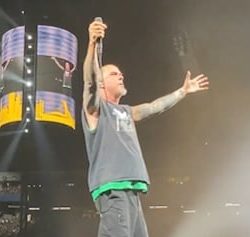
See PANTERA Play Second Concert As Support Act For METALLICA On ‘M72’ Tour
PANTERA played its second concert as the support act for METALLICA on the “M72” tour last night (Friday, August 11) at Stade Olympique in Montreal, Quebec, Canada. Fan-filmed video of PANTERA’s performance can be seen below. Additional support at the gig came from MAMMOTH WVH.
PANTERA’s setlist was…

“I was close to being kicked out of school. A therapist suggested guitar playing would help me with my behavior and grades…”: Peruvian shredder Charlie Parra had an unlikely path to success – but Eddie Van Halen was always his guiding light
The Kramer signature artist was raised on pop-punk and nu metal, but there weren’t enough guitar solos for his liking. Discovering EVH and Randy Rhoads was “mind-blowing” for the young guitarist – and his career hasn’t let up since
Read more »